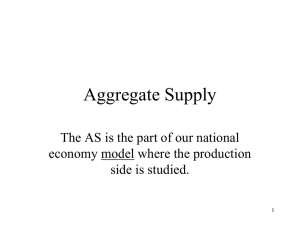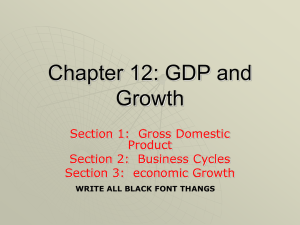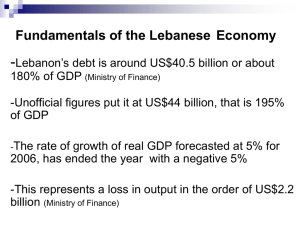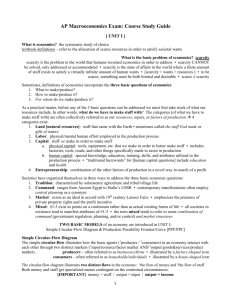Economic Growth rate
advertisement
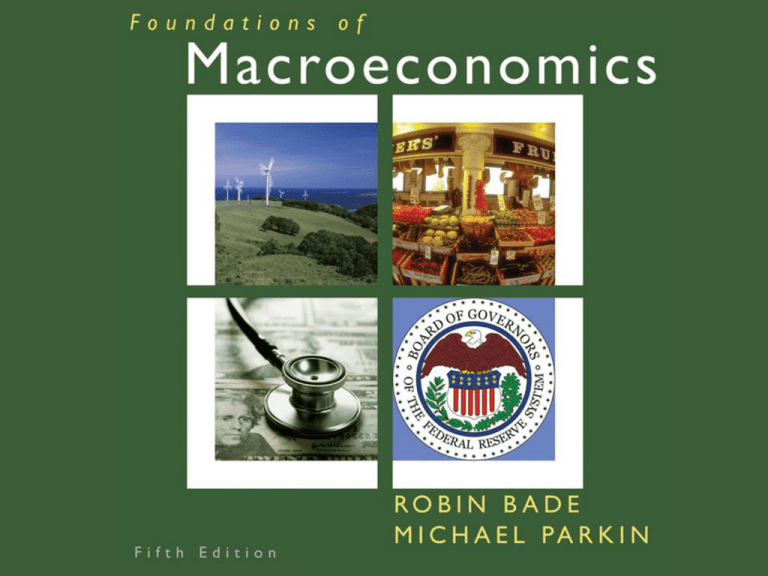
Economic Growth
CHAPTER
9
EYE ONS
Economic growth rate
Classical growth theory
Neoclassical growth theory
New growth theory
Malthusian theory
Real GDP per person
Rule of 70
Property rights
Labor productivity
Economic freedom
DEFINITION
Economic Growth
Sustained expansion of PPF measured as an increase in
RGDP
Economic Growth rate
Percentage change of RGDP
RGDP per Person
–Measures contribution of RGDP standard of living change
–RGDP per Person ONLY GROWS if RGDP grows faster
than population
Sustained growth of RGDP per Person will
make a poor country rich.
DEFINITION
Rule of 70
Calculates the number of years it takes any variable to
double (70/annual % growth rate)
Table 9.1 Growth Rates
Growth rate
(% per year)
2
7
Years for level
to double
35
10
Example
U.S. real GDP per person
China real GDP per person
WHAT DETERMINES RGDP GROWTH RATE
To Understand Growth Rate of RGDP
Must understand: What determines the growth rate of the
factors of production
Land
Labor
RGDP
Capital
Entrepreneurship
All influences on RGDP Growth Increase either:
•Quantity of Labor (Aggregate Hours)
•Labor Productivity
WHAT DETERMINES RGDP GROWTH RATE
Quantity of Labor (Aggregate Hours)
•Increase in average hours worked per week [this # iin U.S.]
•Increase when labor force increases
• Participation in labor force [there is a limit]
• Population growth [only sustainable source]
•Must be accompanied by more productive labor
Labor Productivity
Quantity of RGDP produced by one hour of labor
•Labor productivity grows RGDP per Person grows
•Growth in labor productivity increased standard of living
WHAT DETERMINES QUANTITY OF LABOR
GROWTH
• Population Growth
• Labor Force Participation Rate
• Average Hours Worked
Labor Force depends on
–Labor force participation rate
• Labor Force has upper limits
–Population
• Population growth is ONLY sustainable source of
growth in quantity of labor
Population Growth = economic growth
But only brings RGDP growth if labor becomes
more productive
WHAT DETERMINES LABOR PRODUCTIVITY
GROWTH
Saving and Investment in Physical Capital
•Increase amount of capital per worker
•Increase labor productivity.
Expansion of Human Capital
•Education and training
• 90% graduate High School
• 60% attend college {that is not the # that graduate}
•Job experience
Discovery of New Technologies
•Physical Capital must increase to benefit from Technology
Advancements
•Human Capital is more powerful but Physical Capital is more
plentiful
WHAT DETERMINES LABOR PRODUCTIVITY
GROWTH
Capital must increase
• Physical capital: cars vs horse & carriage, machines, R&D
departments
• Human capital: writing, mathematics [physics, plastics]
How Fast Has Real GDP per Person Grown?
•Real GDP per person hovered around $100 per year from until 1350!
•Around 1750, the Industrial Revolution began and by 1850, real GDP per
person was twice its 1650 level.
•By 1950, real GDP per person was more than five times its 1850 level. And
by 2000, it was four times its 1950 level.
How Fast Has Real GDP per Person Grown?
2009, RGDP/person was
almost 8 times the 1909 level an average growth rate of 2%
But growth has been uneven:
•1930s = no growth
•1940s = fastest growth.
Growth has slowed since the
1960s.
Divide the 1990s into before
and after the Internet, growth
has picked up since 1994.
2009 was a year of deep
recession.
1999-2009 growth rate is lower than in
any decade except the 1930s.
2000’s PGDP growth rate was higher
the that of 1990s
U.S. Labor Productivity Growth
Since 1960
•The 1960s were years of rapid human capital growth and technological change .
•The contribution of human capital growth and technological change slowed during the
1970s. Why?
•Contribution of human capital and technology remained low until the 1990’s spurring
two decades of labor productivity growth
U.S. Labor Productivity Growth Since 1960
Three reasons:
1. Oil price hikes in 19731974 and in 19791980
diverted technological change toward saving energy
rather than increasing labor productivity.
2. Taxes and government regulation increased during
the late 1960s and 1970s, which weakened incentives
and labor productivity growth slowed.
3. Rapid inflation distorted saving and investment
decisions and shortened the time horizon over which
firms made their borrowing and lending plans.
The contribution of human capital and technological change remained
low until the new economy era of the 1990s, when…
Computer and information technologies kicked in to bring faster labor
productivity growth again.
ECONOMIC GROWTH THEORIES
Classical Growth Theory – Smith, Malthus in the 18
th
century
Exploding population and limited resources will result in
an END to economic growth
• Technology advances & accumulation of capital bring
increased productivity and increased RGDP/person
• Increase in RGDP per Person is temporary because
Prosperity brings population growth
•
•
•
•
Increased population = decrease in amount of capital per hour
Thus, RGDP per Person and productivity decrease
By 2200 we run out of resources and return to primitive living
Technological change would not help the situation
• Economics = Dismal science
[All of this happened before America existed]
[There was a population explosion occurring at the time
of this theory’s development]
EFFECTS of POPULATION GROWTH
Draw the Graph
ECONOMIC GROWTH THEORIES
Neoclassical Growth Theory – Robert Solow of MIT in 1960s
RGDP per Person will increase as long as technology keeps
advancing
BASICALLY- Population growth and technological change determine but
are not influenced by the RGDP growth rate
Neoclassical Theory Predicts:
• RGDP growth rate will = population growth +labor productivity growth
• RGDP per person will increase as long as technology advances
economic growth persists
Population growth (two opposing forces offset each other):
• As income increases the birth rate decreases
• As income increases the death rate decreases
ECONOMIC GROWTH THEORIES
Neoclassical Growth Theory – Robert Solow of MIT in 1960s
RGDP per Person will increase as long as technology keeps
advancing
Technological Change (result from chance (luck))
• Businesses expand and are created to exploit new technologies
• Investment and savings increase capital per hour of labor
increase
Prosperity lasts because there is no population explosion
Growth will only last as long as technology advances
Biggest Issue with this theory:
They do not explain what determines technological change
[The population explosion ended and people realized population was
related to economic factors but not as stated under the classical theory]
ECONOMIC GROWTH THEORIES
New Growth Theory – Romer of Stanford in 1980s (Schumpeter in the 1930’s
Our unlimited wants will lead us to ever greater productivity and
perpetual economic growth
RGDP Grows because of the choices people make pursuing a profit
Facts about Market Economies emphasized:
• Human capital grows because of choices
• People decide about school, education, and training
• Discoveries result from choices
• New technologies depend on how many people are looking and
how hard they are trying – not by chance
• Discoveries bring profit, competition destroys profit
• Competition drives people to find better ways, reduce costs, etc.
• Physical capital can be replicated
• Benefits spread
• Many people can use technology at the same time
• The economy does not experience diminishing returns by adding
new facilities
EFFECT of INCREASE IN LABOR PRODUCTIVITY
Graph it
EFFECT of PERPETUAL MOTION
New Growth Theory describes…
PRE CONDITIONS to ECONOMIC GROWTH
Economic Freedom –
People can make personal choices
•Society is free of corruption, barriers to trade, illegal markets,
high taxes, stringent regulations on firms, banks, and labor.
•Does not have to be a democracy {Hong Kong}
Property Rights –
Social arrangements that govern the protection of private property
•Physical, Financial, Intellectual property rights are incentives to
work and save
Markets –
Freely exchange information, products, services
•Enable people to trade, save, and invest
HOW TO ACHIEVE ECONOMIC GROWTH
Must Increase one of the following:
• Growth rate of capital per hour of labor
• Growth rate of human capital
• Pace of technological change
Policies that Achieve these things:
•
•
•
•
•
Create incentives to save, invest, and innovate
Encourage savings
Encourage research and development
International trade
Improve quality of education
Time table
• Slow and steady but benefits are large!
FORMULAS
Growth of
real GDP =
Real GDP in
Real GDP in
current year – previous year
x 100
Real GDP in previous year
Growth of
real GDP =
per Person
Real GDP per Person Real GDP per Person
in current year –
in previous year
x 100
Growth of
Population =
Real GDP in previous year
Population in
current year –
Population in
previous year
x 100
Real GDP in previous year
Growth of real
= Growth rate of –
GDP per person
real GDP
Years to
Double =
Growth rate of
population
70
Annual Percentage Growth Rate
FORMULAS
Labor
Productivity =
Real GDP
Qty labor hours (aggregate hours)
Real GDP = Aggregate hours x Labor productivity
EYE on CONVERGENCE AND GAPS
Why Are Some Nations Rich and Others Poor?
Political stability, property rights protected by the rule of law,
limited government intervention in markets:
Are key features of the economies that enjoy high incomes
and they are the features missing in those that remain poor.
Most of the rich nations have experienced sustained
economic growth over many decades.
Europe’s Big 4 economies (France, Germany, Italy, and the
United Kingdom) have been enjoying economic growth for
200 years.
The United States started to grow rapidly 150 years ago and
overtook Europe in the early 20th century.
EYE on the
CONVERGENCE
PAST
AND GAPS
Why Are Some Nations Rich and Others Poor?
In the past 50 years,
the gaps between these
countries haven’t
changed much.
In a transition from
Communism to a
market economy,
Central Europe is
growing faster than the
United States.
EYE on the
CONVERGENCE
PAST
AND GAPS
Why Are Some Nations Rich and Others Poor?
Economic growth in
Central and South
America and Africa has
been persistently slow.
The gap between the
United States and
these regions has
widened.
EYE on the
CONVERGENCE
PAST
AND GAPS
Why Are Some Nations Rich and Others Poor?
Real GDP per person
in East Asian
economies has
converged toward that
in the United States.
These economies are
like fast trains running
on the same track at
similar speeds with
roughly constant gaps.
EYE on the
CONVERGENCE
PAST
AND GAPS
Why Are Some Nations Rich and Others Poor?
Hong Kong and
Singapore are the lead
trains and run about
15 years in front of
Taiwan,
20 years in front of
South Korea, and
almost 40 years in front
of China.
EYE on the
CONVERGENCE
PAST
AND GAPS
Why Are Some Nations Rich and Others Poor?
Between 1960 and
2008,
Hong Kong and
Singapore transformed
themselves from poor
developing economies
to take their places
among the world’s
richest economies.
EYE on the U.S. ECONOMY
U.S. Labor Productivity Growth Since 1960
The figure shows that
labor productivity
growth
and its changing
trends.
Rapid growth in the
1960s was followed by
slower growth after
1969 and even slower
after 1974.
EYE on the U.S. ECONOMY
U.S. Labor Productivity Growth Since 1960
It is this productivity
growth slowdown that
brought the enormous
$284,500 per person
Lucas wedge.
Why does labor
productivity growth
fluctuate?
EYE on YOUR LIFE
How You Influence and Are Influenced
by Economic Growth
Many of the choices that you make affect your personal
economic growth rate—the pace of expansion of your own
standard of living.
These same choices, in combination with similar choices
made by millions of other people, have a profound effect on
the economic growth of the nation and the world.
The most important of these choices right now is your choice
to increase your human capital.
EYE on YOUR LIFE
How You Influence and Are Influenced
by Economic Growth
A choice that will become increasingly important later in your
life is to accumulate a pension fund.
This choice provides a source of income for you when you
eventually retire.
But it also provides financial resources that firms can use to
finance the expansion of physical capital.
Not only do your choices influence economic growth;
economic growth also has a big influence on you—on how
you earn your income and on the standard of living that your
income makes possible.
EYE on YOUR LIFE
How You Influence and Are Influenced
by Economic Growth
Because of economic growth, the jobs available today are
more interesting and less dangerous and strenuous than
those of 100 years ago.
Today’s jobs are hugely better paid.
But for many of us, economic growth means that we must
accept change and be ready to learn new skills and get new
jobs.
